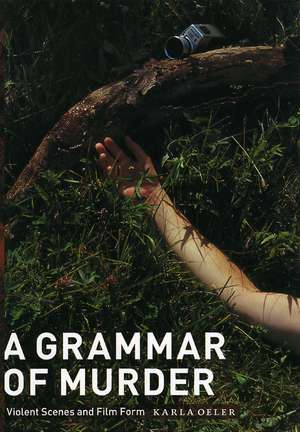A Grammar of Murder: Violent Scenes and Film Form
Autor Karla Oeleren Limba Engleză Paperback – 23 noi 2009
The dark shadows and offscreen space that force us to imagine violence we cannot see. The real slaughter of animals spliced with the fictional killing of men. The missing countershot from the murder victim’s point of view. Such images, or absent images, Karla Oeler contends, distill how the murder scene challenges and changes film.
Reexamining works by such filmmakers as Renoir, Hitchcock, Kubrick, Jarmusch, and Eisenstein, Oeler traces the murder scene’s intricate connections to the great breakthroughs in the theory and practice of montage and the formulation of the rules and syntax of Hollywood genre. She argues that murder plays such a central role in film because it mirrors, on multiple levels, the act of cinematic representation. Death and murder at once eradicate life and call attention to its former existence, just as cinema conveys both the reality and the absence of the objects it depicts. But murder shares with cinema not only this interplay between presence and absence, movement and stillness: unlike death, killing entails the deliberate reduction of a singular subject to a disposable object. Like cinema, it involves a crucial choice about what to cut and what to keep.
Reexamining works by such filmmakers as Renoir, Hitchcock, Kubrick, Jarmusch, and Eisenstein, Oeler traces the murder scene’s intricate connections to the great breakthroughs in the theory and practice of montage and the formulation of the rules and syntax of Hollywood genre. She argues that murder plays such a central role in film because it mirrors, on multiple levels, the act of cinematic representation. Death and murder at once eradicate life and call attention to its former existence, just as cinema conveys both the reality and the absence of the objects it depicts. But murder shares with cinema not only this interplay between presence and absence, movement and stillness: unlike death, killing entails the deliberate reduction of a singular subject to a disposable object. Like cinema, it involves a crucial choice about what to cut and what to keep.
Preț: 211.35 lei
Preț vechi: 250.75 lei
-16% Nou
Puncte Express: 317
Preț estimativ în valută:
40.44€ • 42.37$ • 33.52£
40.44€ • 42.37$ • 33.52£
Carte indisponibilă temporar
Doresc să fiu notificat când acest titlu va fi disponibil:
Se trimite...
Preluare comenzi: 021 569.72.76
Specificații
ISBN-13: 9780226617954
ISBN-10: 0226617955
Pagini: 304
Ilustrații: 187 halftones
Dimensiuni: 152 x 229 x 15 mm
Greutate: 0.41 kg
Ediția:1
Editura: University of Chicago Press
Colecția University of Chicago Press
ISBN-10: 0226617955
Pagini: 304
Ilustrații: 187 halftones
Dimensiuni: 152 x 229 x 15 mm
Greutate: 0.41 kg
Ediția:1
Editura: University of Chicago Press
Colecția University of Chicago Press
Notă biografică
KarlaOeler is associate professor of film studies at Emory University.
Cuprins
List of Illustrations
Acknowledgments
Introduction
Part One: Murder and Montage
1 FRAMING FOR MURDER: CUT-INS AND CLOSE-UPS
The Human Face, the Murder Weapon, and the Close-Up
How Guns Get Attention in Film Theory
Case Study: Vsevolod Pudovkin’s The Heir of Genghis Khan (aka Storm over Asia, 1928)
Murder and Perspectival Scale: Eisenstein’s “Hidden Montage”
2 ACTING IN SILENTS: MURDER, MONTAGE, ANDTHE FILM ACTOR
The Body in Pieces
Man, Montage, and the Machine Aesthetic
Case Study: Lev Kuleshov’s By the Law (1926)
The End of St. Petersburg (1927): Bringing Life to a Statue
Aural Montage and Pudovkin’s Deserter (1932)
Anatomy as Alphabet and the Occlusion of Interiority
Putting Stanislavsky Actors through the Montage Machine: Revolvers and Revolutionary Consciousness in The Mother (1926)
Coda: Eisenstein, Inner Speech, and Murder
3 MURDER OUTSIDE THE POETICS OF MONTAGE: ANDRÉ BAZIN AND JEAN RENOIR
André Bazin and the Preservation of Loss
Bazinian Ambiguity and the Murder Scene
Murder Scenes in Renoir’s Films of the1930s: An Overview
Case Study: Jean Renoir’s The Crime of Monsieur Lange (1936)
The Rules of the Game (1939)
A Montage of Distractions: Murder in La Chienne (1931), Toni (1935), La Bête humaine (1938), and La Marseillaise (1938)
Part Two: Murder and Genre
4 INDIVIDUAL AND SERIES
Montage and Genre
Manny Farber and the Logic of Genre
Case Study: Jules Dassin’s The Naked City (1948)
“Cosmetics on a Cadaver”: James Agee on War Films
5 STYLIZATION AND MIMESIS
Murder as Stylization
Mildred Pierce (1945)
Style and the Man
Murder in the Mirror: The Shining (1980) and Dead Man (1995)
Conclusion: Hitchcock’s Aerial Views
Notes
Bibliography
Index
Acknowledgments
Introduction
Part One: Murder and Montage
1 FRAMING FOR MURDER: CUT-INS AND CLOSE-UPS
The Human Face, the Murder Weapon, and the Close-Up
How Guns Get Attention in Film Theory
Case Study: Vsevolod Pudovkin’s The Heir of Genghis Khan (aka Storm over Asia, 1928)
Murder and Perspectival Scale: Eisenstein’s “Hidden Montage”
2 ACTING IN SILENTS: MURDER, MONTAGE, ANDTHE FILM ACTOR
The Body in Pieces
Man, Montage, and the Machine Aesthetic
Case Study: Lev Kuleshov’s By the Law (1926)
The End of St. Petersburg (1927): Bringing Life to a Statue
Aural Montage and Pudovkin’s Deserter (1932)
Anatomy as Alphabet and the Occlusion of Interiority
Putting Stanislavsky Actors through the Montage Machine: Revolvers and Revolutionary Consciousness in The Mother (1926)
Coda: Eisenstein, Inner Speech, and Murder
3 MURDER OUTSIDE THE POETICS OF MONTAGE: ANDRÉ BAZIN AND JEAN RENOIR
André Bazin and the Preservation of Loss
Bazinian Ambiguity and the Murder Scene
Murder Scenes in Renoir’s Films of the1930s: An Overview
Case Study: Jean Renoir’s The Crime of Monsieur Lange (1936)
The Rules of the Game (1939)
A Montage of Distractions: Murder in La Chienne (1931), Toni (1935), La Bête humaine (1938), and La Marseillaise (1938)
Part Two: Murder and Genre
4 INDIVIDUAL AND SERIES
Montage and Genre
Manny Farber and the Logic of Genre
Case Study: Jules Dassin’s The Naked City (1948)
“Cosmetics on a Cadaver”: James Agee on War Films
5 STYLIZATION AND MIMESIS
Murder as Stylization
Mildred Pierce (1945)
Style and the Man
Murder in the Mirror: The Shining (1980) and Dead Man (1995)
Conclusion: Hitchcock’s Aerial Views
Notes
Bibliography
Index
